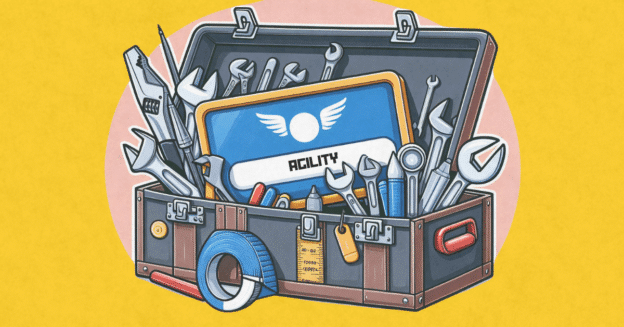As technology evolves, Product Owners and Managers are continually seeking innovative tools to streamline processes and enhance productivity. Generative AI (GenAI for short) stands out as a transformative force, promising to revolutionize the way we handle various product management tasks. However, with great power comes great responsibility. It’s crucial to understand and respect the balance between leveraging GenAI’s capabilities and maintaining the essential human element in product development.
GenAI isn’t just a trendy gadget in the product management toolkit; it’s a game-changer. It brings to the table an ability to process vast amounts of data, generate creative solutions, and provide insights at a speed unattainable by human teams alone. But it’s not a silver bullet. The real magic happens when GenAI’s efficiency is combined with the nuanced understanding, experience, and creativity of a human team. In this landscape, the art of Prompt Engineering emerges as a critical skill. It involves crafting precise and effective prompts that guide GenAI to generate outputs that are not just relevant but also valuable in the context of specific product management objectives.
The Basics of Prompt Engineering and GenAI
Understanding the fundamentals of GenAI and Prompt Engineering is essential for Product Owners and Managers looking to integrate this technology into their workflows.
What is GenAI?
Generative AI refers to the type of artificial intelligence that is capable of generating novel content, from textual data to images and beyond. It operates by learning from vast datasets and then using this learned information to generate new, original material that is often indistinguishable from human-generated content. In the context of Product Management, GenAI can be a powerful ally – from analyzing market trends to brainstorming product features, it can offer insights and outputs at an unprecedented scale and speed.
Relevance to Product Owners and Managers
For Product Owners and Managers, GenAI can serve as a potent tool to augment their capabilities. It can assist in various aspects of product development, including but not limited to, data analysis, customer feedback interpretation, competitive research, and even in the creative process of ideation. By automating and accelerating these tasks, GenAI frees up valuable time for Product Managers, allowing them to focus on strategic decision-making and deeper customer engagement.
Introduction to Prompt Engineering
Prompt Engineering is a critical skill in the age of GenAI. It involves the crafting of clear, concise, and effective prompts that guide the AI to produce the most relevant and useful output. The quality of the output is directly proportional to the clarity and specificity of the prompt given to the AI. In other words, a well-crafted prompt leads to a high-quality output, while a vague or poorly constructed prompt may result in irrelevant or unusable results.
The Significance of Precise Prompt Crafting
The art of creating effective prompts is what sets apart successful GenAI implementations in Product Management. A precise prompt can lead to insightful and actionable outputs, which can significantly influence the product development cycle. For instance, a prompt designed to analyze user sentiment about a specific feature can provide in-depth insights into customer preferences, helping in making data-driven decisions. Similarly, prompts can be designed to generate creative solutions to common user problems, thereby aiding in feature ideation and development.
Check out our AI section for more information on how to navigate effective Prompt Engineering.
Accelerating Product Management Tasks with GenAI

GenAI’s ability to process and analyze information at a scale and speed beyond human capacity is revolutionizing key aspects of product management. From deep-diving into market research and analysis to creatively generating user stories and product features, GenAI is rapidly becoming an indispensable tool for Product Owners and Managers. This technological advancement enables professionals to navigate the complexities of their roles with enhanced precision and agility, reshaping the traditional approaches to developing, managing, and evolving products.
Market Research and Analysis
- Streamlining Data Synthesis: GenAI can quickly synthesize vast amounts of market data, extracting key trends, patterns, and insights. This capability allows Product Owners to stay ahead of market dynamics and make data-driven decisions.
- Sentiment Analysis: GenAI tools can analyze customer sentiments across social media, forums, and review platforms, offering a comprehensive view of public perception and feedback regarding products or services in the market.
Generating User Stories and Personas
- Persona Development: GenAI can assist in creating detailed user personas by analyzing demographic data, user behavior, and preferences, ensuring that products are tailored to meet the specific needs of target customers.
- User Story Automation: Through GenAI, Product Managers can generate user stories that capture the essence of user requirements. This not only speeds up the backlog creation process but also ensures a user-centric approach to product development.
Ideation for Product Features and Improvements
- Creative Brainstorming: GenAI can be employed to generate a wide array of innovative ideas for product features and improvements. It can suggest unique combinations and ideas that might not be immediately obvious, sparking creativity in the product development team.
- Feature Validation: Leveraging GenAI for predictive analysis can help in assessing the potential success and impact of proposed features, guiding Product Owners in prioritizing the development pipeline.
Drafting Project Proposals and Documentation
- Automated Documentation: GenAI can significantly reduce the time and effort required to draft project proposals, technical documentation, and user manuals. It ensures that documents are comprehensive, clear, and tailored to the intended audience.
- Consistency and Quality Control: With GenAI, there’s a guarantee of consistency in the language and style across various documents. This uniformity is crucial, especially in large organizations where multiple teams collaborate on a single project.
From deep market analysis to the generation of user stories and innovative features, GenAI acts as a force multiplier, enabling teams to focus on strategic planning and decision-making while it handles the heavy lifting of data processing and content generation. However, it’s important to remember that GenAI is a complement to, not a replacement for, the human creativity and decision-making that lie at the heart of successful product management.
The Art of Crafting Effective Prompts
Mastering the art of having a conversation with a computer (or Prompt Engineering) ensures that GenAI tools produce outputs that are not just relevant, but also deeply aligned with the specific needs of an Agile team. Let’s cover some strategies and tips for improving the output of your next GenAI chat session.
Strategies for Creating Detailed and Specific Prompts
- Clarity and Precision: Effective prompts are clear and specific. Instead of vague requests, provide detailed information about what you need. For example, instead of saying, “Create a user story,” specify, “Create a user story for a time-tracking feature aimed at remote workers.”
- Context Matters: Include context in your prompts. The more GenAI understands the situation, the more relevant its outputs. If you’re working on a healthcare app, for instance, include specifics about healthcare regulations or patient needs.
- Objective-Driven Prompts: Always align your prompts with the ultimate goal of your task. If the objective is to generate ideas for improving user engagement, frame your prompt to focus specifically on engagement metrics or user feedback.
Don’t Do This. Do This.



Tips for Iterative Refinement of Prompts Based on Initial GenAI Responses
GenAI lends itself to very fast Inspect and Adapt cycles. The relatively low cost to get started with tools such as ChatGPT or Copilot means you can experiment to get the results that work for you. Here are some tips to iterate your prompting:
- Analyze and Adjust: Evaluate the initial output from GenAI. If it misses the mark, tweak your prompt to be more specific, or provide additional background information.
- Incremental Refinement: Start with a broad prompt and gradually refine it based on the outputs. This iterative process helps in homing in on the most effective language and detail level.
- Feedback Loops: Use the responses from GenAI as a feedback mechanism. If a particular phrasing or detail level consistently yields better results, make a note of it for future prompts.
- Collaborative Review: Involve team members in reviewing and refining prompts. Different perspectives can help in creating more comprehensive and effective prompts.
Crafting effective prompts for GenAI is a blend of art and science. It requires a deep understanding of your goals, a keen eye for detail, and a willingness to iteratively refine your approach. As you master this skill, you’ll unlock the full potential of GenAI in product management, leading to more insightful, innovative, and effective outcomes.
Collaborative Acceptance Criteria Development
I absolutely hate that most GenAI Demoes for Product Owners show POs using GenAI to write Acceptance Criteria. THIS IS A TERRIBLE, HORRIBLE, NO-GOOD IDEA! While Generative AI (GenAI) has found its way into various facets of Agile and Scrum methodologies, its application in crafting Acceptance Criteria is a path fraught with pitfalls. This critical aspect of product development demands a nuanced, human-centric and team-centric approach, which GenAI, as of now, cannot adequately provide.
The Critical Role of Human Collaboration
Crafting Acceptance Criteria is the core of refinement and is a critical step in a team developing enough understanding of a problem to solve it. These are tools we might use to better define the work to be done. When a team crafts AC together, they will deepen their understanding of the users needs and be better situated for success. This is never something that should be outsourced to a machine brain.
If you feel you can get away with letting a machine write AC, then don’t write AC. You are wasting your time.
What next?
As Product Owners and Managers navigate the evolving landscape of Agile and Scrum with the integration of Generative AI (GenAI), the journey doesn’t end with mastering the use of GenAI and understanding its limitations. There’s always a next step, a further path to explore. Here’s what lies ahead in this journey:
Continuous Learning and Adaptation
- Stay Updated: The field of GenAI is rapidly evolving. Keeping abreast of the latest advancements and understanding how they can be applied to product management is crucial.
- Experiment and Adapt: Don’t hesitate to experiment with new ways of using GenAI. Adaptation is key in a landscape that’s constantly changing.
Expanding the Use of GenAI
- Beyond the Basics: Once you’re comfortable with the basics of GenAI and Prompt Engineering, consider exploring advanced applications that can further streamline your workflows and enhance creativity.
- Integrating with Other Tools: Look into how GenAI can be integrated with other tools and platforms you use. This holistic approach can unlock new synergies and efficiencies.
Fostering a Culture of Innovation
- Encourage Team Experimentation: Foster a culture where team members are encouraged to experiment with GenAI in their areas of work. Collective experimentation leads to broader organizational learning.
- Share Learnings: Organize regular sessions to share successes and learnings from using GenAI across the team. This not only spreads knowledge but also inspires others.






















